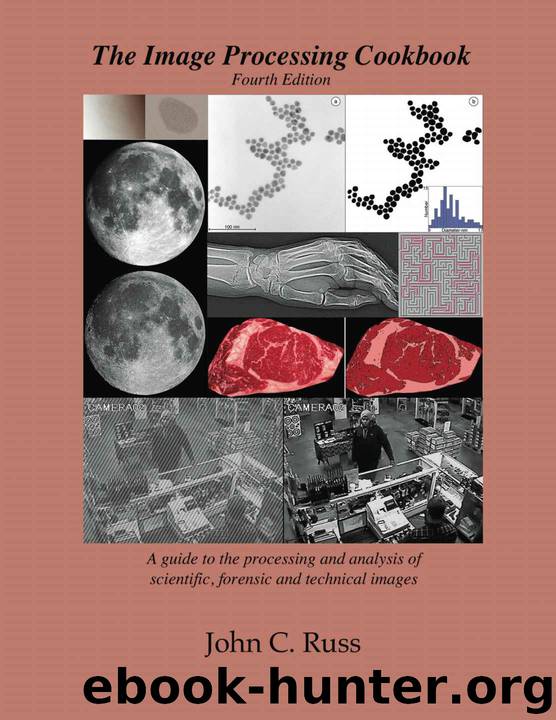The Image Processing Cookbook, 4th Edition by John Russ

Author:John Russ [Russ, John]
Language: eng
Format: azw3
Publisher: UNKNOWN
Published: 2017-04-20T04:00:00+00:00
The FIJI (“Fiji Is Just ImageJ”) download ( https:// ji.sc) includes with ImageJ a set of prepackaged plugins, most of them intended for use on 3D stacks of images from a confocal microscope, and applicable to the study of biological tissue. However, some of these plugins provide speci c routines not present in ImageJ that implement functions illustrated in this text. Examples include:
Anisotropic diffusion and bilateral lters
Kuwahara lter for edge sharpening
Several deconvolution methods
Additional algorithms for automatic threshold determination
EDM-based watershed segmentation
Analysis of skeletons by removal of terminal branches
Registration (alignment) of multiple images, intended for a 3D data set but also generally
applicable to focus stacks
The documentation for each plugin is provided by the individual authors, usually on separate websites or by reference to publications that show an example of use, and is highly variable and often minimal.
Appendix E - Image-Pro Plus This appendix summarizes a basic set of commands that implement the functions illustrated in the text, using Media Cybernetics Image-Pro Plus <http://www.mediacy.com/index.aspx? page=IPP>. The program is typically sold in conjunction with a light microscope, and includes interface software for microscope control and image capture. It runs only under Windows. The notes correspond to version 7.0. In order to maintain continuity with older versions and any automatic sequences originally written for them, there are some options and menu selections that are redundant, providing more than one way to access the same function, and some less accurate computations using older algorithms and implementations (for example integer-based) have been retained. In addition to the menu selections described here, the program has scripting and automation capability, some provisions for 3D and time-sequence image handling, and manual editing and annotation features. A full manual is available on-line at <ftp://ftp.mediacy.com/tech/ PDF/IPPReference_7.0.pdf>, which includes extensive information on the data export, automation macro language, and hardware control portions of the package.
Basic image handling Images of various types (gray scale, RGB, 8, 12 or 16 bit, in a variety of storage le types) are read and saved and displayed using the usual commands under the File> menu (also selectable from the tool bar). Each image is displayed in its own window, and the frontmost window with the highlighted name is the one operated on by the processing and measurement routines. Edit>Undo can be used to revert up to the four most recent processing operations.
Images may be converted from one format to another by selecting Edit>Convert To. The result is shown in a separate window and is treated as a new image. Many of the processing functions described below have the option to either replace values in the current image or to create a new image in a separate window.
The Toolbar has tools for enlarging the image on the screen, reading point coordinates and pixel values, selecting regions, measuring point-to-point distances, etc., as well as image annotation tools. Measure>Histogram shows the image histogram, which can be saved to a disk le (e.g., for reading with Excel). For a color image, the color box selects the channel represented.
Most of the functions listed below operate only within a selection, called an AOI (Area of Interest), if one has been de ned.
Download
This site does not store any files on its server. We only index and link to content provided by other sites. Please contact the content providers to delete copyright contents if any and email us, we'll remove relevant links or contents immediately.
What's Done in Darkness by Kayla Perrin(25520)
Shot Through the Heart: DI Grace Fisher 2 by Isabelle Grey(18238)
Shot Through the Heart by Mercy Celeste(18181)
The Fifty Shades Trilogy & Grey by E L James(17794)
The 3rd Cycle of the Betrayed Series Collection: Extremely Controversial Historical Thrillers (Betrayed Series Boxed set) by McCray Carolyn(13208)
The Subtle Art of Not Giving a F*ck by Mark Manson(12937)
Scorched Earth by Nick Kyme(11861)
Stepbrother Stories 2 - 21 Taboo Story Collection (Brother Sister Stepbrother Stepsister Taboo Pseudo Incest Family Virgin Creampie Pregnant Forced Pregnancy Breeding) by Roxi Harding(11086)
Drei Generationen auf dem Jakobsweg by Stein Pia(10236)
Suna by Ziefle Pia(10197)
Scythe by Neal Shusterman(9290)
International Relations from the Global South; Worlds of Difference; First Edition by Arlene B. Tickner & Karen Smith(8644)
Successful Proposal Strategies for Small Businesses: Using Knowledge Management ot Win Govenment, Private Sector, and International Contracts 3rd Edition by Robert Frey(8445)
This is Going to Hurt by Adam Kay(7725)
Dirty Filthy Fix: A Fixed Trilogy Novella by Laurelin Paige(6470)
He Loves Me...KNOT by RC Boldt(5823)
How to Make Love to a Negro Without Getting Tired by Dany LaFerrière(5415)
Interdimensional Brothel by F4U(5322)
Thankful For Her by Alexa Riley(5190)
